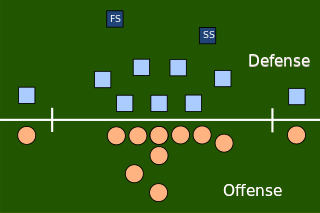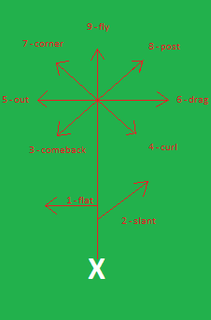
A cornerback (CB) is a member of the defensive backfield or secondary in gridiron football. Cornerbacks cover receivers most of the time, but also blitz and defend against such offensive running plays as sweeps and reverses. They create turnovers through hard tackles, interceptions, and deflecting forward passes.

A wide receiver (WR), also referred to as a wideout, historically known as a split end (SE), is an eligible receiver in gridiron football. A key skill position of the offense, WR gets its name from the player being split out "wide", farthest away from the rest of the offensive formation.

The tight end (TE) is a position in American football, arena football, and Canadian football, on the offense. The tight end is often a hybrid position with the characteristics and roles of both an offensive lineman and a wide receiver. Like offensive linemen, they are usually lined up on the offensive line and are large enough to be effective blockers. On the other hand, unlike offensive linemen, they are eligible receivers adept enough to warrant a defense's attention when running pass patterns.
In gridiron football, blitzing is a tactic used by the defense to disrupt pass attempts by the offense. During a blitz, a higher than usual number of defensive players will rush the opposing quarterback, in an attempt either to tackle him or force him to hurry his pass attempt.
This is a glossary of terms used in Canadian football. The Glossary of American football article also covers many terms that are also used in the Canadian version of the game.
- Legally positioned at the kick-off or the snap. On kick-offs, members of the kicking team must be behind the kick-off line; members of the receiving team must be at least 10 yards from the kick-off line. On scrimmages, at the snap the offence must be behind the line of scrimmage; the defence must be at least one yard beyond the line of scrimmage.
- A player of the kicking team who can legally recover the kick. The kicker and any teammates behind the ball at the time of the kick are onside. Thus on kick-offs all players of the kicking team are onside, but on other kicks usually only the kicker is. The holder on a place kick is not considered onside.
- A defensive position on scrimmages, also called free safety. Typical formations include a single safety, whose main duty is to cover wide receivers. See also defensive back.
- A two-point score. The defence scores a safety when the offence carries or passes the ball into its own goal area and then fails to run, pass, or kick the ball back into the field of play; when this term is used in this sense, it is also referred to as a safety touch.
Strategy forms a major part of American football. Both teams plan many aspects of their plays (offense) and response to plays (defense), such as what formations they take, who they put on the field, and the roles and instructions each player are given. Throughout a game, each team adapts to the other's apparent strengths and weaknesses, trying various approaches to outmaneuver or overpower their opponent in order to win the game.

The 46 defense is an American football defensive formation, an eight men in the box defense, with six players along the line of scrimmage. There are two players at linebacker depth playing linebacker technique, and then three defensive backs. The 46 defense was originally developed and popularized with the Chicago Bears by their defensive coordinator Buddy Ryan, who later became head coach of the Philadelphia Eagles and Arizona Cardinals.
A formation in football refers to the position players line up in before the start of a down. There are both offensive and defensive formations and there are many formations in both categories. Sometimes, formations are referred to as packages.

In sports, a starting lineup is an official list of the set of players who will participate in the event when the game begins. The players in the starting lineup are commonly referred to as starters, whereas the others are substitutes or bench players.
In American football, a zone blitz is a defensive tactic that sends additional players to rush the opposing team's quarterback, whilst also unexpectedly redirecting a supposed pass rushing player into pass coverage instead. This tactic also likely includes zone coverage.

The Tampa 2 is an American football defensive scheme popularized by the Tampa Bay Buccaneers National Football League (NFL) team in the mid-1990s–early 2000s. The Tampa 2 is typically employed out of a 4–3 defensive alignment, which consists of four linemen, three linebackers, two cornerbacks, and two safeties. The defense is similar to a Cover 2 defense, except the middle linebacker drops into a deep middle coverage for a Cover 3 when he reads a pass play.

In American football, the specific role that a player takes on the field is referred to as their "position". Under the modern rules of American football, both teams are allowed 11 players on the field at one time and have "unlimited free substitutions", meaning that they may change any number of players during any "dead ball" situation. This has resulted in the development of three task-specific "platoons" of players within any single team: the offense, the defense, and the so-called 'special teams'. Within these three separate "platoons", various positions exist depending on the jobs that the players are doing.

Safety is a position in gridiron football on the defense. The safeties are defensive backs who line up ten to fifteen yards from the line of scrimmage. There are two variations of the position: the free safety and the strong safety. Their duties depend on the defensive scheme. The defensive responsibilities of the safety and cornerback usually involve pass coverage towards the middle and sidelines of the field. While American (11-player) formations generally use two safeties, Canadian (12-player) formations generally have one safety and two defensive halfbacks, a position not used in the American game.
In American football, a play is a close-to-the-ground plan of action or strategy used to move the ball down the field. A play begins at either the snap from the center or at kickoff. Most commonly, plays occur at the snap during a down. These plays range from basic to very intricate. Football players keep a record of these plays in a playbook.

Zone coverage is a defense scheme in gridiron football used to protect against the pass.

In American football, a 4–3 defense is a defensive alignment consisting of four down linemen and three linebackers. It is called a "base defense" because it is the default defensive alignment used on "base downs". However, defenses will readily switch to other defensive alignments as circumstances change. Alternatively, some defenses use a 3–4 defense.
The following terms are used in American football, both conventional and indoor. Some of these terms are also in use in Canadian football; for a list of terms unique to that code, see Glossary of Canadian football.
The run and shoot offense is an offensive system for American football which emphasizes receiver motion and on-the-fly adjustments of receivers' routes in response to different defenses. It was conceived by former high school coach Glenn "Tiger" Ellison and refined and popularized by former Portland State offensive coordinator Mouse Davis.

A route is a pattern or path that a receiver in gridiron football runs to get open for a forward pass. Routes are usually run by wide receivers, running backs and tight ends, but other positions can act as a receiver given the play.










